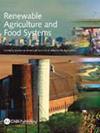有机管理蔬菜系统的带状种植:农艺和环境影响
IF 2
3区 农林科学
Q2 AGRICULTURE, MULTIDISCIPLINARY
引用次数: 0
摘要
摘要本研究评价了在多样化有机蔬菜体系中引入条带的农业环境效益和经济效益。在意大利中部MOnsampolo蔬菜有机长期试验(MOVE LTE)的4年轮作中,进行了三个试验年(2018年、2019年、2020年)的两个试验,以测试带状种植与纯林分种植的对比。两个试验的作物组合为蚕豆(Vicia faba L.) -番茄(Solanum Lycopersicum L.)和小麦(Triticum aestivum) -西葫芦(Cucurbita pepo L.)。我们确定了生产和经济性能、疾病和杂草控制、营养差异和向土壤返回碳的有效性。两种带状种植制度可以更好地利用资源,提高植物生物量和作物残茬,特别是番茄(+24%)和西葫芦(+63%)。然而,更大的植物生物量并不总是导致作物产量的增加。例如,小麦-西葫芦带状种植体系在所有三个试验年份均显示出土地当量比bbbb1,西葫芦产量较高(+产量的54%),而蚕豆-番茄带状种植体系仅在2018年产量更高。相反,后一种系统在所有三个实验年贡献了100亿美元的碳回报。番茄赤霉病(fusarium oxysporum f. sp. lycopersici)和西葫芦赤霉病(oidium spp. oidium spp.)的防治效果与纯林分系统间无显著差异。最后,两项试验中较高的劳动力成本并未影响其盈利能力(蚕豆-番茄和小麦-西葫芦试验分别为+21%和+319%)。总体而言,我们的研究结果指出,农民可以通过引入设计良好的带状种植制度来提高其种植制度的可持续性,这可以降低经济风险,增加潜在的土壤碳,并更有效地利用同一土地上的资源。本文章由计算机程序翻译,如有差异,请以英文原文为准。
Strip cropping in organically managed vegetable systems: agronomic and environmental effects
Abstract This study evaluated the agro-environmental and economic effectiveness of strips introduced in a diversified organic vegetable system. Two experiments of three experimental years (2018, 2019, 2020) were carried out within the 4-year rotation of MOnsampolo VEgetable organic Long-Term Experiment (MOVE LTE) in Central Italy to test strip cropping vs pure stand. The crop combinations in the two experiments were faba bean (Vicia faba L.)–tomato (Solanum Lycopersicum L.) and common wheat (Triticum aestivum)–zucchini (Cucurbita pepo L.). We determined the productive and economic performances, disease and weed control, nutritional differences and effectiveness in returning carbon to the soil. The two strip cropping systems allowed a better use of resources, enhancing plant biomass and crop residues, particularly for tomato (+24%) and zucchini (+63%). However, the greater plant biomass did not always result in an increase in crop yields. For example, while the wheat–zucchini strip system showed a land equivalent ratio >1 in all three experimental years with a high yield performance in zucchini (+54% of yield), the faba bean–tomato system was more productive in strips only in 2018. On the contrary, this latter system contributed a carbon return >1 in all three experimental years. No significant differences between strip and pure stand systems were observed for fusarium (Fusarium oxysporum f. sp. lycopersici) and oidium (Oidium spp.) diseases on tomato and zucchini crops, respectively, and for weed control. Lastly, greater labor costs associated in both experiments did not affect their profitability (+21% and +319% in faba bean–tomato and wheat–zucchini experiments, respectively). Overall, our findings pointed out that farmers could increase sustainability of their cropping systems with the introduction of a well-designed strip cropping system, which can lead to the reduction of economic risks, greater potential soil carbon and more efficient use of resources on the same land.
求助全文
通过发布文献求助,成功后即可免费获取论文全文。
去求助
来源期刊

Renewable Agriculture and Food Systems
农林科学-农业综合
CiteScore
5.20
自引率
7.40%
发文量
39
审稿时长
>36 weeks
期刊介绍:
Renewable Agriculture and Food Systems (formerly American Journal of Alternative Agriculture) is a multi-disciplinary journal which focuses on the science that underpins economically, environmentally, and socially sustainable approaches to agriculture and food production. The journal publishes original research and review articles on the economic, ecological, and environmental impacts of agriculture; the effective use of renewable resources and biodiversity in agro-ecosystems; and the technological and sociological implications of sustainable food systems. It also contains a discussion forum, which presents lively discussions on new and provocative topics.
 求助内容:
求助内容: 应助结果提醒方式:
应助结果提醒方式:


